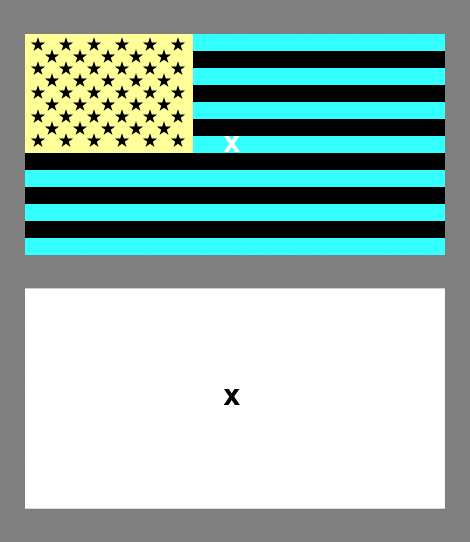
Engineers, when they want to precisely measure something, will often measure the difference of output signals between two separate sensors. This is often done with pressure; for example, one pressure gauge will be at the bottom of river, and another will be nearby in the air, the difference between these pressure measurements is proportional to the water level in the river. This differential measurement eliminates the atmospheric pressure, which is an irrelevant factor.
Human color vision seems to operate using this kind of differential measure. While both cameras and the human eye have various kinds of sensors, some more sensitive to red, others green, and some others to blue light, the eye likely responds to differences in levels between the various kinds, whereas the camera merely records the direct red, green, and blue levels.
The optical illusion above illustrates a number of factors:
- The afterimage shows that the eye has either a kind of persistence of vision, fatigue, or some other process that modifies our perception of color for a while after we look at something. This is by no means a well-understood process controlled by a generally-accepted theory, so plenty of research can still be fruitfully done. The phenomenon seen here can be intensified with those who suffer from migraine headaches.
- This illustrates the opponent process theory of color vision. The cyan, black, and yellow flag briefly turns into an afterimage of red, white, and blue. Opponent colors are those that cancel each other out — such as yellow and blue — and do not mix into an intermediate color. In the afterimage, we see the opponent colors of the original hues. The phenomenon of opponent colors derives from the differential measurement of color. I suspect that the optical illusion we see above is due to the eye's automatic white balance: when the general lighting in a room changes in color, the eye partially or even entirely adjusts to that color, allowing us to still accurately identify colors. Perhaps when we stare at the reverse-image flag, our eyes adjust the white balance: and when we look away, that old white balance persists for a short period, generating the illusion. Digital cameras also have an automatic white balance, which often do a very poor job; film cameras need to have special color film for each lighting condition — or filters over the lens — in order to deliver good white balance.
- The opponent of red is cyan. Many authorities still state that green is the opposite to red, but that is likely not true. The various historical theories of color often conflict, and artists' color wheels, which ought to model the opponent color process, are often inconsistent. These older theories differ in their definition of the primary and secondary colors. Newer research indicates that the primary opponent relationships are red versus cyan, green versus magenta, and blue versus yellow.
- It is the Forth of July weekend: may my American readers enjoy a happy Independence Day!
No comments:
Post a Comment